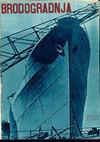STABILITY ANALYSIS FOR TRIMARAN PONTOON ARRAY IN WAVE ENERGY CONVERTER – PENDULUM SYSTEM (WEC - PS)
IF 3.9
4区 工程技术
Q1 ENGINEERING, MARINE
引用次数: 4
Abstract
Ocean waves are a renewable energy source with abundant reserves in Indonesia. With the vast waters of Indonesia, the development of a sea wave power plant needs to be developed. This research focuses on the development of easy-operated and maintained ocean wave converter–pendulum system (OWC – PS). The numerical simulation and experimental analysis were conducted to obtain the relation between the motion response of the pontoon array and its pendulum. The pontoon used is the trimaran type, which consists of a cylindrical pontoon as the main hull and two outriggers on its side. This study analyses the most stable array arrangement that produces maximum pitching motion and pendulum deviation. The simulation results show that the largest pitching value is in array 1, i.e., 27.91° for pontoon 1 and 38.92° for pontoon 2, which results in a maximum pendulum deviation of 100 ° for pendulums 1 and 56.2 ° for pendulum 2 over a wave period of 9 seconds. The backward motion of the pendulum in both array configurations tends to have a greater deviation than that of the forward motion. The pendulums of array 1 have different motion characteristics, represented by different deviation values in both pendulums. This phenomenon does not occur in array 2, since both pendulums in array 2 have the same deviation (with only a small discrepancy).波浪能转换器-摆锤系统中三体浮筒阵列的稳定性分析
海浪是印度尼西亚储量丰富的可再生能源。由于印尼海域广阔,需要开发海浪发电厂。本研究的重点是开发易于操作和维护的海浪转换器-摆锤系统(OWC–PS)。通过数值模拟和实验分析,得出浮筒阵列的运动响应与摆锤的关系。使用的浮筒为三体船型,由一个作为主船体的圆柱形浮筒和侧面的两个支腿组成。本研究分析了产生最大俯仰运动和摆锤偏差的最稳定阵列布置。模拟结果表明,最大俯仰值在阵列1中,即浮筒1为27.91°,浮筒2为38.92°,这导致在9秒的波浪周期内,摆锤1和摆锤2的最大摆锤偏差分别为100°和56.2°。摆锤在两种阵列配置中的向后运动往往比向前运动具有更大的偏差。阵列1的摆具有不同的运动特性,由两个摆中的不同偏差值表示。这种现象在阵列2中没有发生,因为阵列2中的两个摆都具有相同的偏差(只有很小的差异)。
本文章由计算机程序翻译,如有差异,请以英文原文为准。
求助全文
约1分钟内获得全文
求助全文
来源期刊

Brodogradnja
ENGINEERING, MARINE-
CiteScore
4.30
自引率
38.90%
发文量
33
审稿时长
>12 weeks
期刊介绍:
The journal is devoted to multidisciplinary researches in the fields of theoretical and experimental naval architecture and oceanology as well as to challenging problems in shipbuilding as well shipping, offshore and related shipbuilding industries worldwide. The aim of the journal is to integrate technical interests in shipbuilding, ocean engineering, sea and ocean shipping, inland navigation and intermodal transportation as well as environmental issues, overall safety, objects for wind, marine and hydrokinetic renewable energy production and sustainable transportation development at seas, oceans and inland waterways in relations to shipbuilding and naval architecture. The journal focuses on hydrodynamics, structures, reliability, materials, construction, design, optimization, production engineering, building and organization of building, project management, repair and maintenance planning, information systems in shipyards, quality assurance as well as outfitting, powering, autonomous marine vehicles, power plants and equipment onboard. Brodogradnja publishes original scientific papers, review papers, preliminary communications and important professional papers relevant in engineering and technology.
 求助内容:
求助内容: 应助结果提醒方式:
应助结果提醒方式:


